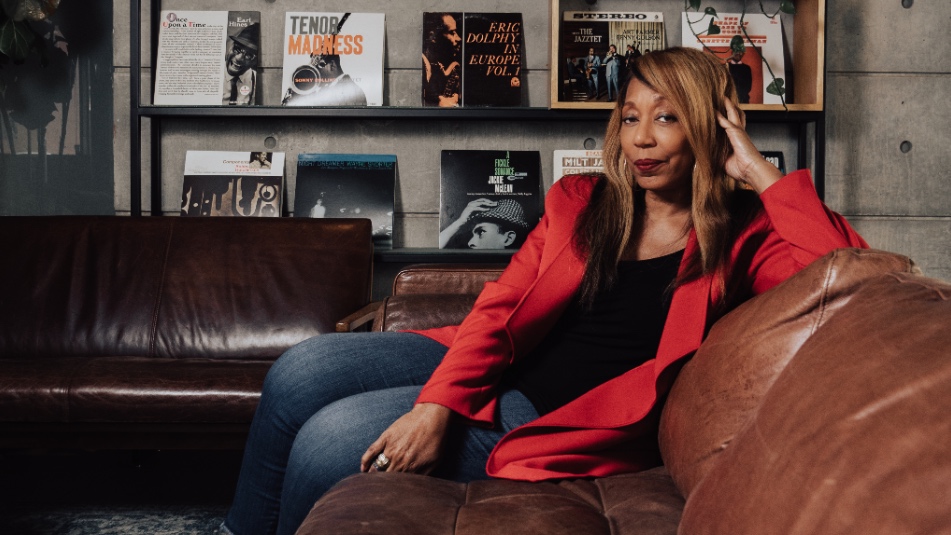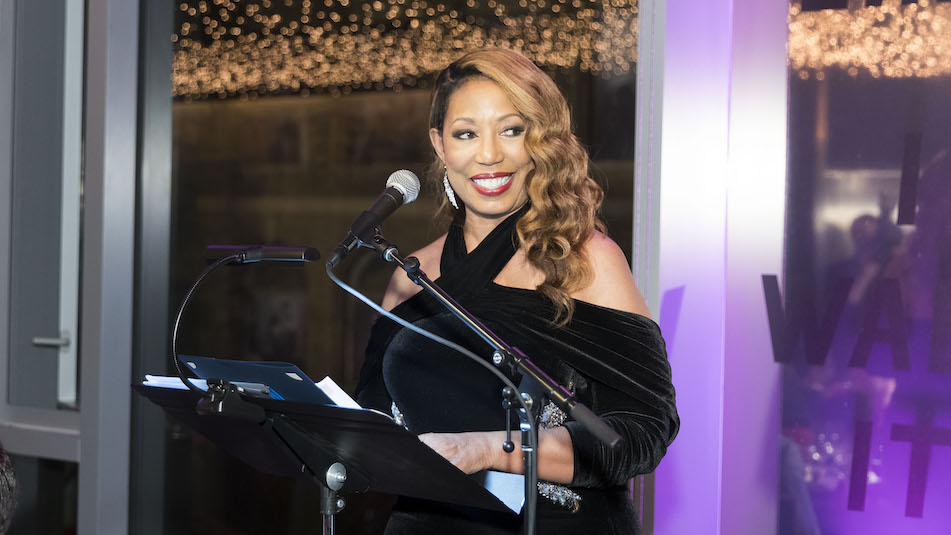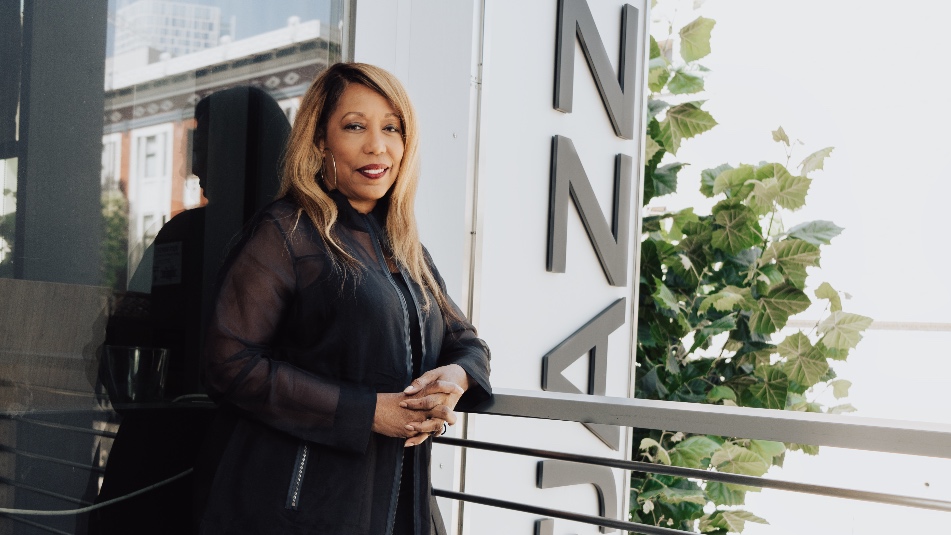SFJAZZ Announces:
Denise Young is named Board of Trustees Chairperson
July 22, 2020 | by Richard Scheinin

Denise Young at the SFJAZZ Center (photo by iindividual.co)
SFJAZZ is excited to announce the appointment of Denise Young as its new Board Chair, beginning on September 1, 2020. Staff Writer Richard Scheinin interviewed Ms. Young about her musical roots, her leadership roles, and her vision for SFJAZZ.
Like a true aficionado, Denise Young refers to jazz as “the music.” She lives in a world where Herbie Hancock is just “Herbie.” And when she mentions “Terrace,” she’s referring to Terrace Martin, the LA-based saxophonist and producer who collaborates with Hancock and Kendrick Lamar. But her love for jazz extends beyond fandom; she identifies with it. Like gospel and the blues, she says, jazz is “historically and culturally important. It chronicles the Black American experience.”
A lifelong singer, whose 2018 album Soprano features her good friend trumpeter Terence Blanchard, Young is a Silicon Valley influencer who broke gender and racial barriers during a 20 plus-year career at Apple.
Bringing together her experiences in jazz and business, on September 1, Young will take over as board chair of SFJAZZ.
This new role is a homecoming for Young, who describes her connection to music like this: “My father was from the South and pretty much only loved the blues. But my mother was such a proponent of the arts that I grew up listening to Ahmad Jamal, Oscar Peterson, Ella, and Carmen McRae too. Sarah Vaughan was my absolute favorite,” she says, speaking from her South Bay home, where she lives with her dog Blakey, named for drummer Art Blakey. “I wanted to be Sarah as a kid! Who thinks that? Those were such prominent voices for me. We had one of those hi-fi TV stereo components, and I would get a pillow, lie down in front of it, and play the records. They even had a secret stash of 78s that I wasn’t allowed to touch, but I would sit and look at them. I understood they were something precious and revered.”
She mentions her son Ian, a graphic artist who enjoys painting while listening to Debussy’s Clair de Lune or Coltrane. His paintings of Billie Holiday, Jessye Norman, Leontyne Price, and Maria Callas hang on the walls of her living room. Passion for the arts and music is a part of her family’s lineage.
The first Black woman to join Apple’s C-suite executive team, Young carried her arts background into the “details of design” aesthetic that characterized the company. She acted as a cultural architect for the worldwide rollout of Apple Stores. She expanded and oversaw diversity and inclusion policies, and she implemented college tuition reimbursement and student loan refinancing programs for employees. She also opened the way for the first “women geniuses” at Apple’s Genius Bar tech support stations. Young still exchanges texts with the first Black female Genius and has an iPhone full of contact info for many other proteges from over the years.
Now she proposes to play a transformative role at SFJAZZ: “When you have leadership that is representative, that is diverse,” she says, “then the tone and culture of the organization has an opportunity to shift.”
A member of the Board of Trustees since 2016, she says SFJAZZ is “absolutely” ready for change — and is intent upon it. “This is not a complacent organization,” she says. “This is an organization that wants to grow and learn and evolve.”
But she is candid about the challenges it faces. SFJAZZ champions Black music, and until the pandemic shuttered the SFJAZZ Center back in March, it presented more than 400 concerts annually. Yet its leadership is largely white, and so are its audiences, in some ways reflecting the gentrification of San Francisco. In the wake of George Floyd’s killing in Minneapolis, as the nation reckons with its history of systemic racial injustice, it makes sense that SFJAZZ should do some reckoning of its own, Young says.
“Where are our church communities?” she asks. “Where is our East Bay community? And where is our young, globally diverse virtual community as we expand digitally? I think we have a responsibility to reach and engage these broader audiences.”
Like many arts organizations around the world, the pandemic has forced SFJAZZ to explore new digital directions to find new audiences and create new revenue streams. Given her background in tech, SFJAZZ is counting on Young to help lead the way. “I spent 20 years at a company that prioritized designing an experience through its products,” she says of Apple. “That’s part of the lens that I plan to bring to these digital offerings. We can transcend the capacity of the hall, minimize some of the barriers, and be more inclusive to communities that aren’t usually able to attend.”
She is devoted to the weekly streaming series Fridays at Five, drawn from SFJAZZ’s archive of videotaped concerts. Since launching in March, it has generated a subscriber base of 8,000 viewers who tune in for hour-long shows featuring the likes of Hancock, Cuban piano master Chucho Valdés, singer Lizz Wright and the Preservation Hall Jazz Band. “I have my ritual,” Young says, describing her preparations for the broadcast. “I get my dinner and glass of wine, and 10 minutes before it starts, I get my online `chat’ activated.” Asked to name her favorite shows so far, she says, “Herbie and the Wayne Shorter dedication was great, of course… and Pres Hall. I danced through that one. I was chatting with the SFJAZZ staff and friends and we were all bragging about the hot Second Line steps we were doing to the music.”
As a performer, Young has collaborated with Pulitzer Prize-winning composer and saxophonist Henry Threadgill and with the jazz duo Tuck and Patti. She has performed classical works in the Bay Area, New York, and Italy, often maneuvering her recital schedule around her job at Apple. In or outside of the concert hall, she finds jazz to be “powerful, compelling, and magical. It opens people up. It’s a fertile ground for enriching human conversations. I can’t tell you how many times I’ve stood in the lobby after a show, and people are gathered and talking about what moved them. In these painful times, I feel it’s historically important—at least to me—that I am taking on this role. Because of what has happened in our nation, this fever pitch that we’ve reached around race relations, inequality, and intolerance—we cannot tolerate this level of inequity and injustice any longer. For me to take this role for this genre and historical art form at this moment—it’s an honor, and an opportunity for my approach and perspective to change the culture.”
Already, she has taken steps toward that change.

Denise Young at SFJAZZ Gala 2020 honoring Mavis Staples (photo by Drew Altizer)
As co-chair of the SFJAZZ 2020 Gala, she drove the decision to honor the great gospel and soul singer Mavis Staples with a Lifetime Achievement Award – and to surround Staples with admirers like Bonnie Raitt, Rosanne Cash, and Lizz Wright. It was the first time the annual event has so unequivocally highlighted the voices of women, she says. Wright has since joined the SFJAZZ Collective, the organization’s all-star band, along with bassist Aneesa Strings, who grew up in Oakland and performed as a teenager with the SFJAZZ High School All-Stars. All of this, Young says, “amplifies the role of women moving forward.”
She notes that men and women of color now occupy seven seats on the 26-member board of trustees and that she is “actively recruiting.” In addition to Young, they include Angela Davis, the author and political activist; Claude Steele, the Stanford social psychologist known for his research on racial and gender stereotyping; and John Santos, the percussionist, bandleader, and scholar of Afro-Caribbean music. She has spoken to each about staking out areas of influence within the organization: collaborating with SFJAZZ’s resident artistic directors; deepening the “social and cultural awareness” component of the organization’s educational outreach to Bay Area schools; and engaging with diverse communities and age groups through the rollout of new digital products in the coming months.
“I’m putting everybody to work,” she says. “I’m already movin’ and shakin' folks into action!”
Young attributes her work ethic to her father, Leon Young, the son of a Louisiana sharecropper. He walked 12 miles to school and worked from the time he was a boy. He later became the first and only Black mayor of Colorado Springs, Colorado, where Denise grew up. An only child, she recalls his lectures about keeping her nose to the grindstone: “I was immersed in arts and culture, and he told me, `All that’s wonderful, but you must get your education, be self-sufficient in business, and be able to survive as a Black woman in this world.’”
Meanwhile, her mother, Margaret Young – raised in Brooklyn – immersed her daughter in dance classes and music lessons. Denise sang at Trinity Missionary Baptist Church in Colorado Springs, where she came to realize “that I did not have the traditional Black wailing voice for which church choirs or R&B are known. I felt insecure about that, like, `I know I love to sing, I know I have a voice, but it doesn’t sound the way everyone around me sounds.’ And it took a very astute church choir director to say, `Let me introduce you to Leontyne Price. Let me introduce you to Marian Anderson. That’s your voice. You see, you have your place in this world.’”
She and her mother spent summers exploring the arts in New York, while visiting family in Bedford-Stuyvesant, where Denise’s grandmother lived two doors from U.S. Congresswoman Shirley Chisholm. “I saw my first Broadway show when I was around eight years old. It was `The Amen Corner’ with Beah Richards. I got to experience all kinds of shows, museums, ballets. The first time I saw a Black ballet dancer was watching Arthur Mitchell and his team” at a theater in Brooklyn. “All those things imprinted in subtle ways—I could see myself in all those expressions of art.”
Flash forward to her college years at Grambling State University, the historically Black university in Louisiana. She was a member of its touring dance troupe, the Orchesis Dance Company, and majored in journalism and communications. After graduation, she worked as a reporter at the Gazette Telegraph in Colorado Springs, covering arts and entertainment. One of her first assignments was interviewing actor Billy Dee Williams.

Denise Young at the SFJAZZ Center (photo by iindividual.co)
In 1995, she attended a job fair for Black professionals in Colorado Springs, where she met recruiters from Apple. The company hired her locally and later transferred her to its Cupertino, California, headquarters, where she began her corporate ascent. In 2000, she was named Head of Retail Human Resources, spending the next 14 years launching Apple Stores—and designing their work environment with Steve Jobs and Ron Johnson, the company’s Senior Vice President of Retail Stores. While hiring and training store teams across the world, she became the first Black woman to be promoted to Vice President in the company’s history. In 2014, she was promoted again, this time to Vice President of Worldwide Talent and Human Resources. Her work as a “cultural architect” at Apple, she says, sometimes reminded her of the choir director who helped her find her voice. Her work at Apple was about “liberating employees”—inspiring them to discover and optimize their unique voices and talents.
For all her successes, Young’s ascent was not without hardships: “As the only Black woman in a room, on a team, I frequently felt that my voice went unheard. Sometimes others in the room talked over me, and sometimes my specific view was too different from theirs… It was challenging when my voice went unheard or misunderstood.” Owning her “voice,” whether physically or metaphorically, has been a theme throughout Young’s life and career. Just as making her voice heard could be a battle in Apple’s rarified corporate world, she says, having it heard clearly by the media has presented unique challenges on top of that.
In 2017, Young was invited to participate in a panel at a world youth conference in Bogota, Colombia. Asked to define her philosophy of diversity and inclusion, and whether she prioritized the advancement of Black women at Apple, she launched into a lengthy response. She described diversity as “the human experience,” and touched on the historic predicaments of Black women and the LGBT community. She described her strategy of focusing on “allies and alliances.” Speaking to a roomful of young people from more than 100 countries, she said that diversity is a complicated idea with many different expressions. She added, “There can be 12 white blue-eyed, blond men in a room, and they are going to be diverse, too.”
That single sentence became a soundbite that national news stories latched onto in critique of Young. Looking back, she says, “In reality, it was taken out of context. The point was you could have any homogenous group of 12 people, and they can still be different as human beings. The problem with that homogenous group is its lack of representation. Broad representation is imperative; it’s what we strive for and what makes any collaborative work great. The media took that sentence out of context and distorted its meaning, but the people who know me knew exactly what I meant and what I stood for. They said, ‘You were the person who scored the biggest corporate gift in history for HBCUs (Historically Black Colleges and Universities), who fought for the first female Geniuses in the Apple Stores,’ and that legacy is how I see myself, the same legacy passed down through my father.”
Starting in 2016, Young had been talking with Apple CEO Tim Cook about leaving the company and re-focusing her work on the arts. She already had formed her own arts organization called Blue Organza, named for the silky blue organza dresses she wore to vocal recitals as a girl. She had already begun recording her album Soprano in 2013 with Blanchard, spoken word GRAMMY nominee Sekou Andrews, and a number of the Bay Area’s top jazz musicians, including drummer Leon Joyce and bassist Gary Brown.
The album, released in 2018, includes her rendition of Duke Ellington’s “Come Sunday.” A duet with pianist Daric V. Jackson, it is lovely: quiet, soulful. You listen and think about the kid who was mesmerized by her parents’ record collection, by Carmen McRae and Sarah Vaughan. As Young prepares for her next chapter at SFJAZZ, she feels she’s come full circle.
She believes “human connection is most effectively established through art, and the human condition is best understood through it. Jazz and Black American music has chronicled our history, laid bare our pain, communicated our hopes and dreams better than any other vehicle.”
Young wants to show that music can be “a lens for humanity to see itself more clearly and fully.” She regards her life as “a quest to look at the world through music, to live in the world that music takes you to.” It's a world, she believes, that she and SFJAZZ can build together.
Read the official SFJAZZ Press Release
A staff writer at SFJAZZ, Richard Scheinin is a lifelong journalist. He was the San Jose Mercury News' classical music and jazz critic for more than a decade and has profiled scores of public figures, from Ike Turner to Tony La Russa and the Dalai Lama.
